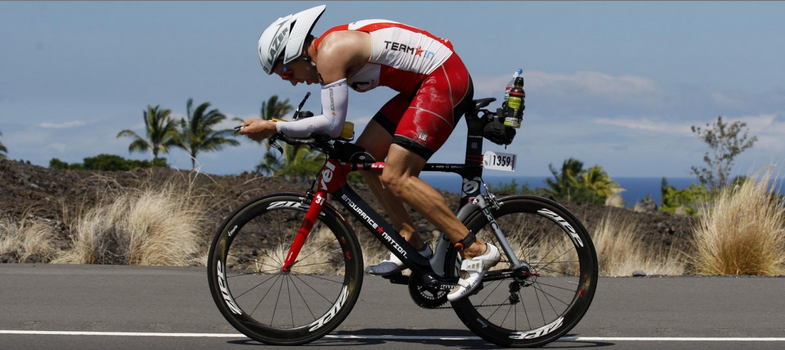This is an excerpt of the first chapter of Endurance Nation’s upcoming eBook Crossing the Line: Everything You Need to Know About Racing Your First Ironman® But Were Afraid To Ask, a new resource for first time Ironman® competitors. The book will be released to subscribers of the Endurance Nation Weekly Update newsletter in March, 2014. Sign up for the newsletter using the form below to receive your free copy of the eBook.
A 112 mile bike ride is certainly daunting, much less after a 2.4 mile swim and before 26.2 mile run! In fact, the bike will occupy almost half of your race day, and probably a larger percentage of your training week. Yep, see that shiny rig in the corner? You’re going to be spending a LOT of time together over the next several months.
The Bike is Not the Run
Running is an impact sport. One of the fundamental keys of Ironman® run training is to build the durability that enables the training you need for a successful Ironman® run.
But the bike is fundamentally different from the run:
- Non-impact: cycling has none of the forceful jarring and impact of the run. In fact, cycling, on a stationary bike, is often prescribed for people returning from heart surgery or other significant health events.
- Bio-mechanically less risk: consider that your feet are nailed to pedals, which are bolted to straight cranks, which are attached to round chainrings. These power a round wheel and all of this lives inside a fixed frame that you sit on, the exact same way every time you swing a leg over the bike. There is very little that can go wrong in this system. Assuming a well-fitting bicycle and a successful avoidance of fixed objects in your line of travel (ie, you don’t crash) your risk of injury on the bike is much less than on the run.
The net is that the bike, and therefore bike training, is much less risky than the run, from an injury, overuse, or overtraining perspective. It warrants an approach different from the run:
 Get Faster, NOW!
Get Faster, NOW!
Even as a beginner cyclist, you should absolutely not wait to become a much faster cyclist! Getting faster is a four step process:
- Place butt on bicycle.
- Go → that way → really fast.
- Recover
- Repeat
Wait for the “It’s On Day”
Please review our concept of the “It’s On Day,” discussed in the first chapter of this ebook. Every Endurance Nation athlete, even our first-timers, trains according to this Get Fast process above up until their IOD, at which time they begin to shift gears and build Ironman® endurance on top of this much faster bike.
Sound crazy or different from what your training partners are doing, with months and months of 4-6 hour Zone 1 bike rides? In our experience (again, over 1000 Ironman® finishers per year since 2010), those athletes are getting very good at riding slowly for hours and hours. No amount of riding 17mph will miracle itself into an 19mph bike split on race day.
“A Rising Tide Lifts All Boats”
Let’s say that if we were to staple you to a bike seat, put a gun to your head and told you to ride as hard as you can for an hour, you’d average 19mph. If the next day we took the gun away but told you ride for 4-5 hours, you’d ride at some slower percentage of this 19mph, simply because you’re on the bike longer. Let’s call it 17mph.
If we came back the next week, and the next, and the next with our staple gun and .38, your 19mph one hour time trial would become 19.5mph, then 19.7, then 20, 21 mph, etc. Likewise, your 4-5 hour speed would also rise.
By making yourself faster at shorter distances, you also make yourself faster at longer distances, assuming you put some endurance on top of this one hour speed…which you certainly are with your 4-5 hour non-gun-enhanced bike rides.
But the opposite is not also true. That is, no amount of riding day after day at 17mph that will miracle itself into the ability to ride 19mph on race day. Or rather, you can get faster but in our experience this volume method begins to work when you rack up north of about 15hrs of cycling per week, a completely unrealistic volume for 99.99% of the readers of this ebook!
Your Bike as a Personal Cool $%!& Vehicle
Your bike is a vehicle you can use to do some pretty cool and epic…stuff. Your fitness is the engine that powers your Cool $%!& Vehicle to cool places. But first time Ironman® athletes often get so torqued up about building the engine (usually incorrectly) that they miss out on many opportunities to do cool stuff with their Cool $%!& Vehicle.
We recommend you:
- Put cool events on your calendar: hard, long, up, down, in an epic venue…whatever. If it’s challenging and sounds like fun, sign up!
- Encourage, dare, or pester your friends into signing up also.
- Train for your cool event, in route to your Ironman.
You’ll gain the confidence of challenging yourself and have fun, en route to your Ironman.
[box Our new eBook, Crossing The Line: Everything You Need to Know About Racing Your First Ironman® But Were Afraid To Ask is available for download now! Get your copy today.
[button color=”red” size=”large” link=”https://www.endurancenation.us/landing/crossing-the-line/”]Download[/button]


Leave a Reply